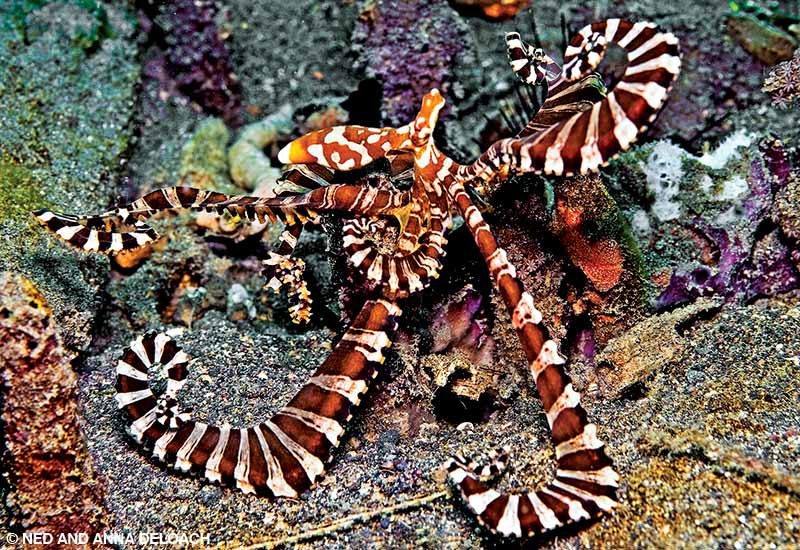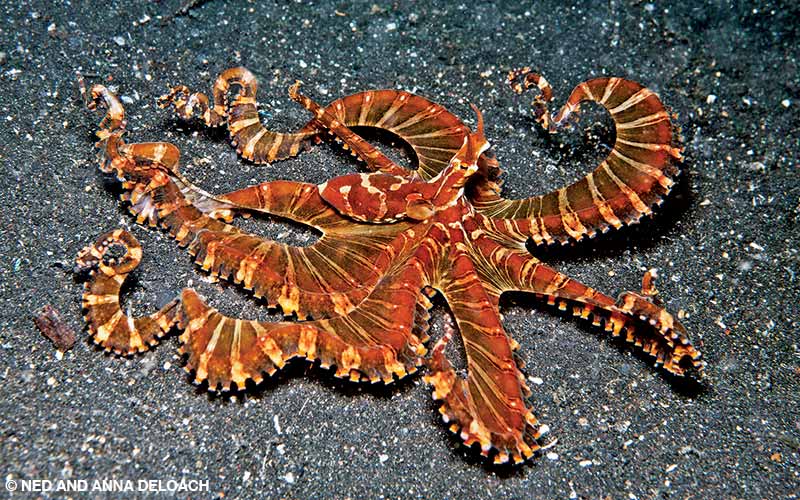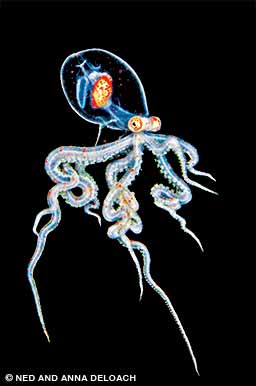Who says scientists aren’t poetic? Certainly not the trio of cephalopod specialists from California and Australia who in 2006 scientifically described and officially named one of the sea’s most captivating creatures, Wunderpus photogenicus — yes, the same highly prized, saucer-sized, long-armed octopus from Asia-Pacific waters that underwater photographers and naturalists had been fondly calling the “wonderpus” since the mid-1980s. And what an animal it is!
In 1995, when we first explored wunderpus territory, which overlies much of the Coral Triangle, the then-undescribed octopus’ fame had spread far and wide. The newly sensational creatures attained much of their acclaim for dancing like dandies across sandy seafloors on eight unimaginably limber arms — an eye-popping feat of acrobatic dexterity well worth traveling halfway around the world to see.
As Anna and I quickly learned, you don’t so much go hunting for octopuses but rather happen upon them. Like the wunderpus, the other members of their eight-armed clan don’t particularly enjoy the company of divers. When discovered in the open, reef octopuses typically remain motionless and rely on adaptable camouflage. By contrast, sand-dwelling species such as the wunderpus magically melt into the soft bottom and are seldom seen again. Even though they are naturally reserved, there is little doubt that octopuses, reputed to be the most intelligent of all the invertebrates, can be quite curious at times. Wunderpuses are no exception.

We occasionally happened upon a show-off that not only appeared pleased to have us nearby but also seemed to take pleasure exhibiting just how amazing an octopus can be. These treasured dancers prance across the seafloor in ever-changing configurations, with their arms coiling, curling and corkscrewing into rare works of high octopus art. What could such melodrama be about?
Christine Huffard, Ph.D., a senior research specialist at Monterey Bay Aquarium Research Institute, spent years in Indonesia videoing the behavior of octopuses in the wild. “No one knows for sure exactly what the wunderpus dance means,” she wrote in response to my inquiring email. What I had called dancing, she has categorized in her research papers as multiarm walking — a slow form of escape meant to confuse predators by muddling their search image. “But it could also be a flamboyant display in threatening situations,” she added.
Even though the wunderpus now has a proper name, we know little about its behavior. Helping sort out such things has long been one of our favorite underwater pastimes, although our efforts routinely produce more questions than answers. In 2008 Anna and I saw a Frisbee-disc-sized female striking a pose reminiscent of a Balinese dancer. Although undoubtedly aware of our presence, the wunderpus held itself as still as a statue. I glanced around to locate a motive for the curious behavior but saw no rival, mate or potential meal anywhere.

After long, motionless minutes, the octopus began undulating its arms as if conjuring a spell before collapsing to the bottom and casually gliding away in a more typical octopus fashion across the flat, algae-tufted terrain of Lembeh Strait. As it passed a patch of sand, a 3-inch shrimpgoby flew off the bottom as if shot from a sling and smashed into the octopus’ mantle. Unfazed by repeated attacks, the octopus continued until it arrived at the quarter-sized entrance to the goby’s burrow, which was kept in repair by its symbiotic partner, a subterranean snapping shrimp.
With the ease of Jell-O slipping down a drain, the octopus vanished into the hole. After a brief wait, eyestalks reappeared, followed by two slender arms that leisurely stretched to their full length in opposite directions, looking like a banded sea snake. It was impossible to observe what the other six arms were doing inside the burrow or whether the resident shrimp was extracted or consumed. Days later near the same site, we encountered another wunderpus, possibly the same individual, clutching a recently captured snapping shrimp. Even more fantastic were the beaded strands of elliptical wunderpus eggs that dangled within her webbed skirt.

Our wunderpus exploits continued early last year during our final trip before the COVID-19 pandemic struck. This time instead of hunting shallow seafloor muck, we drifted at night high above the 700-foot depths of Balayan Bay near Anilao in the Philippines, squinting into the darkness for specks of larval life. Among our finds was a wunderpus paralarva, or so we were told at the time.
I sent the image to Huffard for her take. Even though she has helped to raise wunderpuses from eggs and authored a paper on the chromatophore patterns of hatchlings, she couldn’t offer a definitive answer. “It could be a wunderpus — it’s definitely possible,” she remarked before noting, “This is one of the many ways the blackwater diving community’s images are so valuable — for potentially piecing together those life stages.”
We certainly didn’t need one, but her enthusiasm for more images is yet another excuse to go diving.
Jelajahi Lebih Lanjut
See a wunderpus in action in this video.
© Alert Diver - Q3/Q4 2021